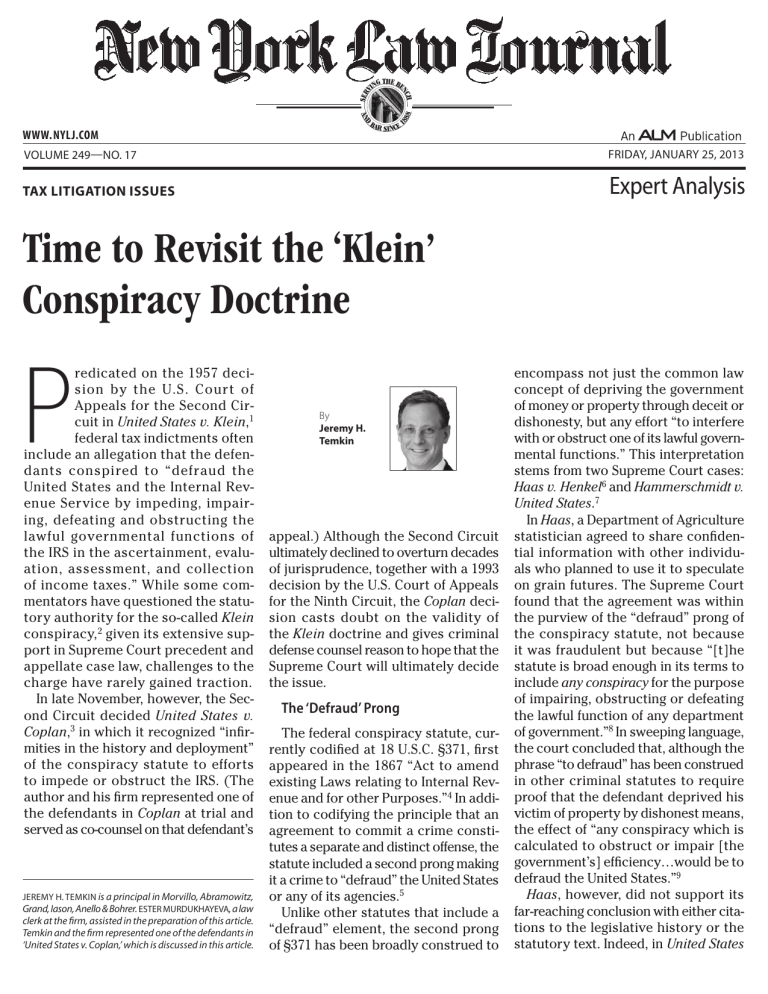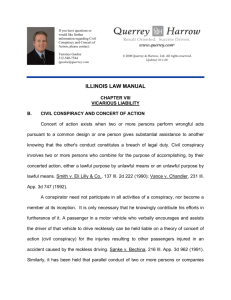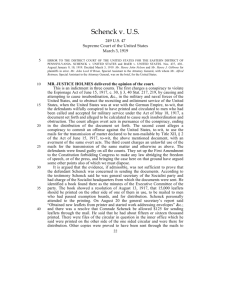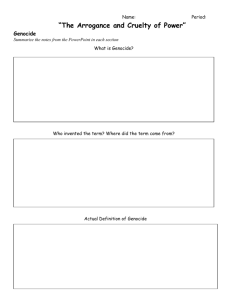
AND
88
8
SER
V
H
NC
THE BE
ING
1
BA
R SINCE
WWW. NYLJ.COM
VOLUME 249—NO. 17
FRIDAY, JANUARY 25, 2013
TAX LITIGATION ISSUES
Expert Analysis
Time to Revisit the ‘Klein’
Conspiracy Doctrine
P
redicated on the 1957 decision by the U.S. Court of
Appeals for the Second Circuit in United States v. Klein,1
federal tax indictments often
include an allegation that the defendants conspired to “defraud the
United States and the Internal Revenue Service by impeding, impairing, defeating and obstructing the
lawful governmental functions of
the IRS in the ascertainment, evaluation, assessment, and collection
of income taxes.” While some commentators have questioned the statutory authority for the so-called Klein
conspiracy,2 given its extensive support in Supreme Court precedent and
appellate case law, challenges to the
charge have rarely gained traction.
In late November, however, the Second Circuit decided United States v.
Coplan,3 in which it recognized “infirmities in the history and deployment”
of the conspiracy statute to efforts
to impede or obstruct the IRS. (The
author and his firm represented one of
the defendants in Coplan at trial and
served as co-counsel on that defendant’s
JEREMY H. TEMKIN is a principal in Morvillo, Abramowitz,
Grand, Iason, Anello & Bohrer. ESTER MURDUKHAYEVA, a law
clerk at the firm, assisted in the preparation of this article.
Temkin and the firm represented one of the defendants in
‘United States v. Coplan,’ which is discussed in this article.
By
Jeremy H.
Temkin
appeal.) Although the Second Circuit
ultimately declined to overturn decades
of jurisprudence, together with a 1993
decision by the U.S. Court of Appeals
for the Ninth Circuit, the Coplan decision casts doubt on the validity of
the Klein doctrine and gives criminal
defense counsel reason to hope that the
Supreme Court will ultimately decide
the issue.
The ‘Defraud’ Prong
The federal conspiracy statute, currently codified at 18 U.S.C. §371, first
appeared in the 1867 “Act to amend
existing Laws relating to Internal Revenue and for other Purposes.”4 In addition to codifying the principle that an
agreement to commit a crime constitutes a separate and distinct offense, the
statute included a second prong making
it a crime to “defraud” the United States
or any of its agencies.5
Unlike other statutes that include a
“defraud” element, the second prong
of §371 has been broadly construed to
encompass not just the common law
concept of depriving the government
of money or property through deceit or
dishonesty, but any effort “to interfere
with or obstruct one of its lawful governmental functions.” This interpretation
stems from two Supreme Court cases:
Haas v. Henkel6 and Hammerschmidt v.
United States.7
In Haas, a Department of Agriculture
statistician agreed to share confidential information with other individuals who planned to use it to speculate
on grain futures. The Supreme Court
found that the agreement was within
the purview of the “defraud” prong of
the conspiracy statute, not because
it was fraudulent but because “[t]he
statute is broad enough in its terms to
include any conspiracy for the purpose
of impairing, obstructing or defeating
the lawful function of any department
of government.”8 In sweeping language,
the court concluded that, although the
phrase “to defraud” has been construed
in other criminal statutes to require
proof that the defendant deprived his
victim of property by dishonest means,
the effect of “any conspiracy which is
calculated to obstruct or impair [the
government’s] efficiency…would be to
defraud the United States.”9
Haas, however, did not support its
far-reaching conclusion with either citations to the legislative history or the
statutory text. Indeed, in United States
FRIDAY, JANUARY 25, 2013
v. Gradwell,10 decided seven years after
Haas, the Supreme Court appeared to
question its own expansive interpretation of the “defraud” prong of the conspiracy statute. In Gradwell, the defendants were charged with conspiring to
defraud the United States by bribing
voters in two congressional elections.
The government argued that because it
has “the right to honest, free, and fair
elections,” a conspiracy to bribe voters would be a “denial and defeat of
this right, and…therefore is a scheme
to defraud the United States.” In rejecting this theory of liability, the court
stated that “it would be a strained and
unreasonable construction to apply
[the conspiracy statute], originally a
law for the protection of the revenue”
to a conspiracy to bribe voters at a congressional election.
Then, in Hammerschmidt, the court
further scaled back the potential expansive interpretation of Haas. In Hammerschmidt, 13 defendants were convicted
of a conspiracy to defraud for having
printed, published and circulated
brochures and handbills encouraging
people not to obey the draft laws.11
The prosecutors sought to justify the
convictions on the grounds that the
defendants’ efforts served to impair
the government’s functioning.
The Supreme Court rejected this argument. Citing Haas, the court explained
that “[t]o conspire to defraud the United States means primarily to cheat the
government out of property or money,
but it also means to interfere with or
obstruct one of its lawful governmental
functions by deceit, craft, or trickery, or
at least by means that are dishonest.”12
Because the defendants’ “open defiance”
of the draft lacked deceit or dishonesty,
it could not support a conviction under
the “defraud” prong.13
In Klein, the defendants were
charged with substantive tax evasion
counts as well as a conspiracy “to
obstruct the Treasury Department in
its collection of the revenue” under
the “defraud” prong of §371. Though
the trial court dismissed the substan-
tive counts, the defendants were convicted of the conspiracy count. In
upholding the conviction, the Second
Circuit applied the Hammerschmidt
principle to the tax context and enumerated several “acts of concealment
of income” that constituted an effort
to interfere with the government’s tax
collection program.14
Together with a 1993 Ninth Circuit decision, the ‘Coplan’ decision casts doubt on the validity of
the ‘Klein’ doctrine.
A “Klein conspiracy” is now common
shorthand for “a conspiracy to frustrate
the government (particularly the IRS)
in its lawful information gathering functions.”15 This construction has indisputably broad reach and can potentially
criminalize “any agreement to behave
unethically in dealings with the Government, which…might in some measure
impair the efficient operation of one of
the Government’s myriad activities,”
leading at least one commentator to
protest that the textual or historical
basis for the theory is still unexplained
and “[a]ll that can be said with certainty about [the conspiracy statute]
is that it was enacted at a time and in
a setting which strongly suggest that
it was aimed at conspiracies either to
commit offenses against the internal
revenue or to defraud the United States
of internal revenue.”16
Ninth Circuit’s Limitation
Prior to the Second Circuit’s opinion
in Coplan, courts had been surprisingly uncritical of the extension of the
“defraud” prong of the conspiracy statute “beyond its common law usage [to]
include[] interference or obstruction
of a lawful government function.”17 A
notable exception was United States v.
Caldwell, a 1993 case in which the U.S.
Court of Appeals for the Ninth Circuit
reversed the conviction of a bookkeeper for a “warehouse bank” that “used
numbered accounts, promised to keep
no records of clients’ transactions and
vowed not to disclose information
about the accounts to third parties.”18
While the bank’s “ostensible goal” was
to maintain client privacy, this privacy
“helped the [bank’s] customers avoid
paying taxes.”
In its jury instructions, the district
court omitted the requirement that the
prosecution prove not merely that the
conspirators agreed to obstruct a lawful
governmental function, but further that
they agreed to do so through deceitful or
deceptive means. In defending the ensuing conviction, the government argued
that any conspiracy to interfere with or
impede the government’s functioning
was unlawful.
In an opinion by Judge Alex Kozinski, the Ninth Circuit began by noting
that while the text of §371 “seems to
cover only defrauding in the normal
sense of the word—acquiring another’s
property by intentional misrepresentations…the [statute] has been read
much more broadly.”19 Given the broad
reach of the statute and its capacity to
“subject[] a wide range of activity to
potential criminal penalties,” the court
lambasted the government’s “spurious”
theory of the “defraud” conspiracy that
would “forbid all things that obstruct the
government, or require citizens to do all
those things that could make the government’s job easier.”20 Though the court
did not address the foundations of the
Klein doctrine, it did express concern
about the doctrine’s reach and sought
to confirm a limiting principle—that the
underlying conduct be illegal, or at the
very least, dishonest and deceitful.
Further Doubts in ‘Coplan’
In Coplan, four partners of Ernst &
Young were prosecuted in connection
with that firm’s promotion of five separate tax shelters in the late 1990s and
early 2000s.21 The indictment alleged
that only one of the five shelters at
issue gave rise to substantive tax eva-
FRIDAY, JANUARY 25, 2013
sion charges, but that the defendants
and their coconspirators structured,
marketed and ultimately defended the
remaining four shelters in a manner that
frustrated and impaired the “lawful government functions of the IRS.”22 Following a 10-week trial, a jury convicted each
of the four defendants on all counts.23
On appeal, the defendants challenged
the Klein conspiracy charge, arguing
that the doctrine is not grounded “on
any principle of statutory interpretation,” but rather is “judicially created”
and justified by “a (judicially generated)
policy concern that government interests deserve greater protection than private interests, and thus that the phrase
‘to defraud the government’ must mean
something broader than the phrase ‘to
defraud a citizen.’”24
Prior to the Second Circuit’s opinion in ‘Coplan,’ courts had been
surprisingly uncritical of the extension of the “defraud” prong of
the conspiracy statute “beyond its
common law usage [to] include[]
interference or obstruction of a
lawful government function.”
Writing for the court, Judge José
Cabranes addressed the defendants’
challenge to the Klein doctrine. Cabranes
noted that the government’s primary
argument in its brief was that the defendants’ claim “is squarely foreclosed by
nearly a century’s worth of established
precedent.”25 For the court, this position
indicated that the government “implicitly concede[d] that the Klein conspiracy is a common law crime…[which]
alone warrants considerable judicial
skepticism.”26 Reviewing the history
of the Supreme Court cases underpinning the Klein conspiracy doctrine, the
court agreed that the “defraud” prong
of §371 has been interpreted differently
because of a “policy judgment that…
government interests justify broader
protection [than] the interests of private
parties—rather than [because of] any
principle of statutory interpretation.”27
In their briefs, the defendants argued
that the U.S. Supreme Court’s decision in
Skilling v. United States,28 which limited
the application of the honest services
fraud statute to kickbacks or bribes and
not to other dishonest conduct, gave
the Second Circuit an opportunity to
correct a judicial overexpansion of
another broadly used criminal statute.
The defendants contended that in Skilling, “[t]he case law had not succeeded
in clarifying the very general statutory
language” of the provision, which led
the Supreme Court to narrow its application. The defendants further argued that
much like the honest services doctrine,
the “defraud” prong of §371 should be
pared to its common law core: limited
to conspiracies “to deprive [the government] of property rights through deceptive means,” not merely to impede or
obstruct its functioning.29
Ultimately, while acknowledging the
“infirmities in the history and deployment of the statute,” the court concluded that it was bound by circuit law and
Supreme Court precedent and rejected
the challenge to the Klein theory. The
court, however, found “the arguments
for breaking loose from the moorings of
established judicial norms by ‘paring’
a statute” to be “persuasive” and suggested that the defendant’s “forceful[]”
Skilling argument should be “properly
directed to a higher authority.”30
The Future of ‘Klein’?
Together with the Ninth Circuit’s decision in Caldwell, the Second Circuit’s
decision in Coplan puts in doubt a
long-accepted and widely used theory
of criminal liability. Given the extensive Supreme Court precedent girding
the government’s interpretation of the
conspiracy statute, the Second Circuit
concluded that only the Supreme Court
can redefine the scope of the prohibition on conspiracies to “defraud” the
government.
Though reversing decades of law
might appear daunting, Skilling demon-
strates the Supreme Court’s willingness
to critically examine the foundations of
criminal liability. The Second and Ninth
Circuits’ thoughtful and well-reasoned
critiques of the Klein conspiracy theory
should lead other courts to reconsider
the doctrine, and defense counsel can
be hopeful that the Supreme Court will
accept the Second Circuit’s invitation
to resolve the issue.
••••••••••••••••
•••••••••••••
1. 247 F.2d 908 (2d Cir. 1957).
2. See, e.g., John A. Townsend, “Tax Obstruction Crimes:
Is Making the IRS’s Job Harder Enough?” 9 Hous. Bus. & Tax.
L.J. 255 (2009).
3. —F. 3d—, 2012 WL 5954654 (Nov. 29, 2012). The Second
Circuit reversed the convictions of two defendants (including
the author’s client) on sufficiency grounds. See Martin Flumenbaum and Brad Karp, “White Collar Conviction Reversed for
Insufficient Scienter,” New York Law Journal (Dec. 26, 2012).
4. Abraham S. Goldstein, “Conspiracy to Defraud the United States,” 68 Yale L.J. 405, 418 (1959).
5. Id.
6. 216 U.S. 462 (1910).
7. 265 U.S. 182 (1924).
8. 216 U.S. at 479 (emphasis added).
9. Id.
10. 243 U.S. 476 (1917).
11. 265 U.S. at 185.
12. Id. at 188.
13. Id. at 189; see also United States v. Ballistrea, 101 F.3d
827, 832 (2d Cir. 1996).
14. 247 F. 2d at 210.
15. United States v. Alston, 77 F.3d 713, 720 (3d Cir. 1996).
See also United States v. Romer, 148 F.3d 359 (4th Cir. 1998);
United States v. Khalife, 106 F.3d 1300 (6th Cir. 1997); United
States v. Goldberg, 105 F.3d 770 (1st Cir. 1997).
16. Goldstein, 68 Yale L.J. at 418, 436.
17. See, e.g., United States v. Licciardi, 30 F. 3d 1127, 1131
(9th Cir. 1994).
18. 989 F.2d, 1056, 1058 (9th Cir. 1993).
19. Id.
20. Id. at 1061.
21. 2012 WL 5954654 at *1.
22. 2012 WL 5954654 at *4. The defendants were also variously charged with substantive tax evasion, individual tax
obstruction and false statement offenses.
23. Id. A fifth defendant pled guilty prior to trial.
24. Brief for Defendant-Appellant Robert Coplan (“Coplan
Brief”) at 28-29, United States v. Coplan, No. 10-cr-583 (2d Cir.
Sept. 30, 2010), quoting McNally v. United States, 483 U.S. 350,
359 n. 8 (1987). One or more of the defendants also challenged, inter alia, (a) the sufficiency of the evidence; (b) aspects of the jury instructions, including a theory of defense
instruction with respect to the Klein conspiracy charge; (c)
the proper venue of the false statements charge; and (d) various evidentiary issues, including the admission of coconspirator statements. As noted above, the Court reversed the
convictions of two of the defendants on sufficiency grounds.
25. Brief for Appellee United States of America at 85, United States v. Coplan, No. 10-cr-583 (2d Cir. Sep. 30, 2010).
26. Id.
27. Id. at *8.
28. 130 S. Ct. 2896 (2010)
29. Coplan Brief at *36-42.
30. Id.
Reprinted with permission from the January 25, 2013 edition of the NEW YORK LAW
JOURNAL © 2012 ALM Media Properties, LLC. All rights reserved. Further duplication
without permission is prohibited. For information, contact 877-257-3382 or reprints@alm.
com. # 070-01-13-36.





